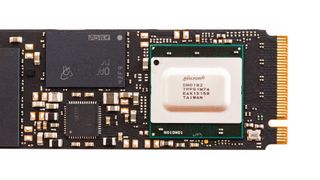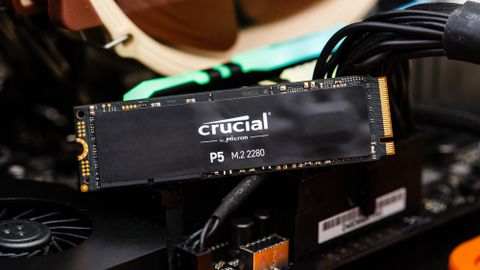Why you can trust Tom's Hardware
With killer components and a sleek, black PCB, the P5 looks to be the enthusiast-class SSD we were wanting from the company for years now. It’s not quite as flashy as Patriot’s flashy Viper VPR100 or Team Groups T-Force Delta Max, but it will tuck away quite nicely under a motherboard’s built-in heatsink, which may be needed since this SSD likes to run hot without any cooling.
Crucial’s P5 has some incredible engineering and technology built into it, but even with all of that, the P5’s performance was average, at best. The company states that the P5 comes with “thousands of hours of Micron pre-release validation, dozens of SSD qualification tests, and a heritage of award-winning SSDs.” However, based on our experience, Crucial still has some work to do on the P5’s firmware to bring its performance up to more competitive levels. The Crucial P5 isn’t nearly as responsive as Adata’s XPG SX8200 Pro, Samsung’s 970 EVO Plus, nor the latest Gen4 NVMe SSDs, where it matters.

The P5’s random 4K read performance is very good, but Adata’s XPG SX8200 Pro was able to attain much faster random speeds with only a dual-core SM2262EN NVMe SSD controller from Silicon Motion and Micron’s older 64L flash. Plus, the P5’s random write performance is slower than average and its read performance suffers at small block sizes and low QDs, which results in poor responsiveness to application requests. And, even though its cache recovery speed is super quick, that trick isn’t enough to help it gain dominance in SPECworkstation 3’s prosumer workloads.
The Crucial P5’s underwhelming application performance doesn’t help its value proposition. However, pricing, warranty, and endurance ratings are all reasonable. At 1TB and warrantied for up to 600TB of writes within five years, the P5 is well within the mainstream territory, but the company could have done more to compete with Phison based SSDS that are boasting incredible endurance ratings that are triple that of the P5.
While the P5 boasts quad-plane NAND and six Arm cores, the higher 512Gb NAND flash die density resulted in less die interleaving, and thus less performance than the competition at 1TB. The Samsung 970 EVO Plus blows the P5 out of the water with its thirty-two 256Gb NAND dies and penta-core Phoenix controller at 1TB, but the P5 is quite a bit cheaper based on capacity. At $150, Crucial’s 1TB P5 is reasonably priced for the performance it provides and is $40 cheaper than the 970 EVO Plus with similar encryption support, too. However, competition from other manufacturers is still very tough. At roughly $135-$140, we would rather recommend the Adata XPG SX8200 Pro or Gammix S11 Pro for those looking for a responsive gaming experience, although their SLC cache doesn’t recover nearly as fast as the P5’s after heavy write workloads and they lack encryption support.
If you need high-speed sustained write performance for media work, the WD Black SN750 is a very good alternative that can sustain quite a bit of write abuse and is similarly priced, although like the P5, read performance lags a bit at low QDs and during small block requests.
For those looking to pinch pennies, WD’s Blue SN550 may be a rather reasonable alternative that costs $45 less than the P5 and comes without the extremely slow write performance that most entry-level SSDs suffer from once its SLC cache exhausts. Even without the use of DRAM, WD’s Blue SN550 proved itself to be more responsive to application requests than Crucial’s P5. It even delivers faster game load performance and puts the P5 to shame when handling SPECworkstation’s prosumer workloads. While the P5’s design may be more robust than most, the performance results from today’s review speak for themselves.
MORE: Best SSDs
MORE: How We Test HDDs And SSDs
MORE: All SSD Content

Sean is a Contributing Editor at Tom’s Hardware US, covering storage hardware.
-
Co BIY Should the 2T model perform better because of greater parallelism with the additional NAND packages ?Reply
Also why is the $/Gig greater at 2T than at 1T? Seems unusual. -
Co BIY I think it would be worth while to run the 1TB version vs the 2TB by placing each as a competitor into the others review heat. That way we not only see how it compares to the same size competition but how they stack up head to head.Reply
Then you can see the choices easily - The drive against the competitors and against itself.
and you get to publish hard earned data twice for more views! -
Avro Arrow From what I've seen, nothing beats the Corsair Force NVMe drive. It has a read/write rating of 4950MBps/4950MBps. Of course, it only gets those speeds with PCI-Express 4.0 so ATM only AMD can really take advantage of it.Reply -
JonnyDough ReplyAvro Arrow said:From what I've seen, nothing beats the Corsair Force NVMe drive. It has a read/write rating of 4950MBps/4950MBps. Of course, it only gets those speeds with PCI-Express 4.0 so ATM only AMD can really take advantage of it.
That may be so for sequential but the Force series does not have the highest random read/write speeds out there... -
seanwebster Reply
That's a good idea, but can get tricky. I wish we could simply update a database for easy to make charts. I will try to include the next closest capacity in with the updated capacity under test, though.Co BIY said:I think it would be worth while to run the 1TB version vs the 2TB by placing each as a competitor into the others review heat. That way we not only see how it compares to the same size competition but how they stack up head to head.
Then you can see the choices easily - The drive against the competitors and against itself.
and you get to publish hard earned data twice for more views!
Well, the 1TB Seagate FireCuda 520 and the 2TB Sabrent Rocket NVMe 4.0 are identical to the Corsair Force MP600, so they all perform the same. You can swap the names for the corsair in the benchmarks above if you want to see how it compares. Samsung's 980 PRO is now out and a few more Gen4 devices are on the way. The Phison PS5016-E16 NVMe controller powering thOse drives is no longer top dog.Avro Arrow said:From what I've seen, nothing beats the Corsair Force NVMe drive. It has a read/write rating of 4950MBps/4950MBps. Of course, it only gets those speeds with PCI-Express 4.0 so ATM only AMD can really take advantage of it. -
Avro Arrow Reply
I believe you. I know that memory is only made by a few companies like Samsung, Hynix and Micron so it would make sense that their top-end products wouldn't just go to Corsair. The Team T-Force CARDEA is pretty close too with theoretical read/write limits of 5000/4400.seanwebster said:That's a good idea, but can get tricky. I wish we could simply update a database for easy to make charts. I will try to include the next closest capacity in with the updated capacity under test, though.
Well, the 1TB Seagate FireCuda 520 and the 2TB Sabrent Rocket NVMe 4.0 are identical to the Corsair Force MP600, so they all perform the same. You can swap the names for the corsair in the benchmarks above if you want to see how it compares. Samsung's 980 PRO is now out and a few more Gen4 devices are on the way. The Phison PS5016-E16 NVMe controller powering thOse drives is no longer top dog.
Jeez, these numbers are getting so big that they're starting to lose all meaning! :D

